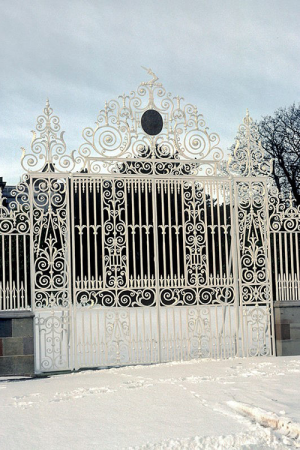Technical Note: Ferrous metals
Definitions
Wrought iron

Wrought iron is composed primarily of iron with 1 to 2% of added slag, the by-product of iron ore smelting - generally a mix of silicon, sulphur, phosphorous, and aluminium oxides. During manufacture, the iron is removed from heat and worked with a hammer while still hot to get it into its intended final form.
Wrought iron is often characterized by its fibrous appearance, but it is also softer and more ductile than cast iron. Wrought iron is highly malleable, meaning it can be heated, and re-heated, and worked into various shapes. In fact, it gets stronger the more it is worked. Wrought iron has a much higher tensile strength than cast iron, making it more suitable for horizontal beams in construction. In general, it strongly resists fatigue. It deforms without failing unless overloaded well beyond capacity or distorted from exposure to intense heat (e.g. from fire).
It was widely used throughout the 19th Century in building construction but was replaced by steel in the 20th Century.
Cast iron
Cast iron is a generic term that refers to a range of iron alloys, but is typically associated with the most common, grey iron. While cast iron may sound like the cast form of pure iron, it is actually an alloy containing 2 to 4% carbon, plus smaller amounts of silicon and manganese. Other impurities, such as sulphur and phosphorus, are also common.
Cast iron is formed by smelting iron ore, or melting pig iron (the product of iron ore extraction), and mixing with scrap metals and other alloys. The liquid mixture is poured into moulds and allowed to cool and solidify. Due to its higher carbon content, cast iron solidifies as a heterogeneous alloy, so it contains several materials in different phases within its microstructure, which affects its physical properties.
For example, cast iron has carbon particles within its microstructure which form elongated graphite flakes when the metal cools. Graphite is low in density and hardness but high in lubricity. So it offers little in terms of structural advantage, but it does compromise the surrounding iron matrix, creating internal stress points that can lead to fractures.
Compared to wrought iron or steel, cast iron is brittle, hard, and non-malleable. It can’t be bent, stretched, or hammered into shape. Its weak tensile strength means that it will fracture before it bends or distorts. It does, however, have good compression strength, and was used prominently in building construction before the advent of the steel industry in the early 20th Century.
Compared to steel, cast iron has a lower melting point, and is more fluid and less reactive with mould materials, making it well-suited for casting. This is a significantly less labour-intensive process than making product out of wrought iron, so it was a prominent form of production throughout the 18th and 19th Centuries. Cast iron has largely been replaced by steel in the construction industry, but it is still used for many industrial applications.
Historic note
Iron has been available for building construction from the 5th century, but until the Industrial Revolution, smelting from ore was a tedious business carried out on a small scale. All the resulting products, down to the smallest of nails had to be hand wrought and in consequence the material was used sparingly. As Ireland had an abundance of timber, charcoal smelting of iron was common, with production peaking in the 1790’s and coming to an end around 1860 due to extensive deforestation.
Britain & Northern Europe, with natural coal resources, took over supply of pig iron, for conversion in Irish foundries, wrought iron or finished iron products. Improved methods of smelting developed and iron in the form of straps, coach screws and the like, gradually replaced the fine timber joinery of earlier constructions.
Unfortunately for us today it was sometimes used instead of more stable metals like bronze to make cramps and ties for masonry work, with consequent failures that have proved very costly to correct.
Casting iron has also been a technique known for many hundreds of years. In building, castings were not in common use until the Industrial Revolution of the late 18th century. Methods had been developed mainly in the production of military ordnance but by the 1770s a wide variety of standard castings were available to buildings including, fire grates, chimney pots, railings, windows, sash weights, locks, latches and hinges, and many others.

The structural use of iron was developed at the same time both as wrought and cast work. Such was the demand for structural ironwork that in the 1840s rolling mills were built to produce standard profiled sections, thus eliminating the time consuming cutting and riveting that had previously been necessary to build up structural sections. The expansion of the railway system and the building of iron ships resulted in enormous growth of the industry. Standard buildings were shipped all over the world and every town of any size could boast its public lavatory, bandstand and its decorative street lamps. Complete iron buildings were constructed; the great train sheds, and conservatories everywhere with of course the most famous of all being The Crystal Palace (1850). The prime examples in Ireland are the Richard Turner glasshouses in the National Botanical Gardens, Dublin and Belfast Botanical Gardens, both precursors to Turner’s Kew Gardens structures.
Techniques of blending in other minerals to give increased strength and durability were perfected and in 1866 the first standard rolled steel joists were available. In recent years welding has taken the place of riveting.
Faults and repair
Corrosion
Old wrought iron is very pure and when exposed to the weather forms a skin of black oxide which protects it against further decay.
However, when it is kept continuously damp, for example in the core of a wall where it has been built in as a cramp or lintel, then it forms red oxide which eats deeply into the body of the iron causing lamination and expansion. The forces released during this expansion are enormous and will burst stones and erupt the surrounding masonry. Once this corrosion has begun it may be aggravated by electrolysis set up as an interaction with run lead which was originally poured to exclude water. As cracks in the masonry open more and more water can enter so that the process gradually accelerates.
Rainwater systems should be painted periodically when it becomes apparent that the surface finish is deteriorating, taking particular care to paint difficult access areas (e.g. the back of downpipes) as these are particularly susceptible to corrosion.
Modern steel corrodes in the same way but very much faster and must always be given a protective coating.
Mild corrosion can be arrested; all oxide and scaling must first be cleaned off. Shotblasting in a workshop is the most effective way otherwise a portable blasting unit must be used. Alternatively the surface must be pecked and wire-brushed by hand. The surface can then be pickled using phosphoric acid, followed by paint priming, galvanizing or other durable protective coating.
If corrosion is really bad then replacement in whole or in part is the only course of repair. When repairing old iron work try to use old iron scrap, possibly salvaged from one of the mass of old farm gates that sadly litter the hedge-rows.
Fracture
Wrought iron fractures only if it is continually subject to changing stresses, but cast-iron fractures very easily due to a more crystalline structure. Provided the object is non-structural it may be possible to glue it back together using epoxy resins. If the component is structural it may be possible to carry the load in some other way and then effect a repair using epoxy resins. If this is impossible then a new casting is the only remedy. Quite a variety of 18th and 19th century casting designs are still available as standard items. Fractured steel can usually be repaired by welding.
All external ferrous metal surfaces should be inspected regularly every three years. If local defects are attended to at this frequency serious decay is unlikely. If not attended to, a very expensive scheme of repair is likely to follow.
Notes on the preparation of contract specifications
Identify the items for replacement, repair and cleaning. Specify what work is to be executed ‘in situ’ and what is ‘shop work’ requiring dismantling and transportation.
Specify protection and storage
Describe the methods to be used in replacement, repair and cleaning and any special protective treatments which will not be covered in the section concerned with painting. If any of the work is to be carried out by specialists make this clear.
Name the standards of workmanship and finish that are required and state if any items are to be approved in the workshop before they are brought to site.
Sources of relevant information
History
- Hoever, O, 1975, A Handbook of wrought Iron from the Middle Ages to the End of the Eighteenth Century, London Thames and Hudson
Maintenance
- Ashurst John and Nichola,1988, Practical Building Conservation volume 4: metals. , London English Heritage
- Building Research Establishment Digest No. 70 - Painting: Iron and Steel.
- Evans VR, 1972, The Rusting of Iron: Cause and control, London
- Edward Arnold Lister R, 1960, Decorative cast iron work in Great Britain, London G Bell and Sons
- BS 7913:2013, Guide to the conservation of historic buildings, BSI Standards Ltd.
Owner guidance notes by other advisory organisations
- Metals, Practical Building Conservation series, English Heritage, 2012
- Irish Period Houses – A Conservation Guidance Manual Dublin Civic Trust 2016. Chapter 19 - Ironwork
- Iron, Heritage Advice Series, Government of Ireland 2009
- Historic Environment Scotland Inform Guide series
Contractors
The Department cannot recommend specific contractors for restoration work. However, this is a skilled field and owners and their agents should satisfy themselves that those they employ have the required skills. Previous examples of their work should be inspected, and recommendations sought.
UK and Ireland contractors who claim to have restoration experience are now listed online; The Directory of Traditional Building Skills, compiled and published by Ulster Architectural Heritage in association with HED can be accessed via the UAH website.
The Irish Georgian Society publishes a list of specialist contractors based mainly in the Republic of Ireland.